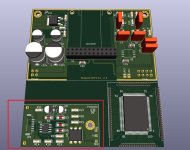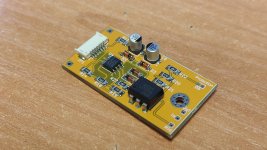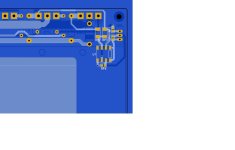Hello all,
I know that is it surely a common title of topic, but I'm working on my new amplifier, and I want to add a DC protection on the output.
I want to manage the output relay with an ESP32 (all function are managed by him). So, "out" will be link to the ESP32.
I seen a schematic from Elektor (July 2012, page 62) interesting, and I simulated on Spice :


All seems work fine, but I want to ask to the diyaudio Engineer here for know if something seems wrong or not 🙂
Thx in advance !
I know that is it surely a common title of topic, but I'm working on my new amplifier, and I want to add a DC protection on the output.
I want to manage the output relay with an ESP32 (all function are managed by him). So, "out" will be link to the ESP32.
I seen a schematic from Elektor (July 2012, page 62) interesting, and I simulated on Spice :
All seems work fine, but I want to ask to the diyaudio Engineer here for know if something seems wrong or not 🙂
Thx in advance !
hello,
@ctrlx, delay yes, it is managed by the MCU, all protection and others are controlled before the relay activating. Output will be triggered by relays, I'm not familiarised with FETs...
@mark, you right, I omitted the R for the simulation (opto), but she is in place on the Kicad project 🙂
Concerning R7, the 15v PSU will be devlivered by 7815-7915, and 1% resistor will be used. I think that if the window detection will move for some millivolts, it will be not a very big problem
Today I created a small PCB that I sent to JLCPCB, I will make all tests with it after receiving.
@ctrlx, delay yes, it is managed by the MCU, all protection and others are controlled before the relay activating. Output will be triggered by relays, I'm not familiarised with FETs...
@mark, you right, I omitted the R for the simulation (opto), but she is in place on the Kicad project 🙂
Concerning R7, the 15v PSU will be devlivered by 7815-7915, and 1% resistor will be used. I think that if the window detection will move for some millivolts, it will be not a very big problem
Today I created a small PCB that I sent to JLCPCB, I will make all tests with it after receiving.
Attachments
Seems a bit inspired by Rube Goldberg. But this is DIYA so it's not about efficiency. I would not put a crash-able uP in charge of anything critical. Using a uP to monitor and display status is a good idea. I would also use the uP to mute and/or set the amp gain, etc. The uPC1237 is easily replaced by a handful of penny transistors which have no availability issues.
http://www.unisonic.com.tw/datasheet/UPC1237.pdf
http://www.unisonic.com.tw/datasheet/UPC1237.pdf
UPC is really difficult to find in original case.
I already tried a project with transistors, but the result was not really good :/
Below the photo of my new project based on the schematic above. I made some tests with DC input and all work like a charm. I just have to test now with very low frequency ( under 20 / 15hz).
I already tried a project with transistors, but the result was not really good :/
Below the photo of my new project based on the schematic above. I made some tests with DC input and all work like a charm. I just have to test now with very low frequency ( under 20 / 15hz).
Attachments
The whole contraption is fascinating and remarkably complex.
I would likely use an amp or a speaker to protect it from failure.
I would likely use an amp or a speaker to protect it from failure.
I'm integrating protection into my "Slewmaster" line of IPS/OPS projects.
- KEEP IT SIMPLE !!
Output stage , power supply, relay, soft-start will have large footprint SMD opto's as optional
They can still run without the MCU interface.
No one will build a small footprint digital control board. If it is a mixed TH/SMD (large SMD) ... maybe ??
Easier to just use a existing China Arduino NANO clone ($4 pre-built module) , has the regulator/uart included with arduino bootloader.
No fuss , just load and plug it onto through-hole SIP's. I2C port expander for "slow" triggers (thermal). NANO is used
for fast stuff (DC,current). Very little SMD work ....through-hole or the large SOT-xxx.
DC can just be 4 transistors ,cap , diodes, and opto - added to the SS relay PCB.
The SS relay (with DC detect) PCB should run independently without the control board needed - speakers are expensive.
ESP32 is overkill for basic protection unless you want to integrate a pre-amp and display.
OS
- KEEP IT SIMPLE !!
Output stage , power supply, relay, soft-start will have large footprint SMD opto's as optional
They can still run without the MCU interface.
No one will build a small footprint digital control board. If it is a mixed TH/SMD (large SMD) ... maybe ??
Easier to just use a existing China Arduino NANO clone ($4 pre-built module) , has the regulator/uart included with arduino bootloader.
No fuss , just load and plug it onto through-hole SIP's. I2C port expander for "slow" triggers (thermal). NANO is used
for fast stuff (DC,current). Very little SMD work ....through-hole or the large SOT-xxx.
DC can just be 4 transistors ,cap , diodes, and opto - added to the SS relay PCB.
The SS relay (with DC detect) PCB should run independently without the control board needed - speakers are expensive.
ESP32 is overkill for basic protection unless you want to integrate a pre-amp and display.
OS
Attachments
I never told that the ES32 was here only for the protection.
My ESP32 is used for control the LCD, keys, rotary, protection, and digital tone control. It is a big and complete project that run around the ESP32.
My ESP32 is used for control the LCD, keys, rotary, protection, and digital tone control. It is a big and complete project that run around the ESP32.
Why not a crowbars implementation:
Just short the rails (after the onboard fuses of course) in case of DC.
Thus avoid relays or mosfets in series with the speaker.
Simple, easy and efficient.
Just short the rails (after the onboard fuses of course) in case of DC.
Thus avoid relays or mosfets in series with the speaker.
Simple, easy and efficient.
My control board will open the SS relays , open the power board rails , and flash one of the digital outputs from the arduino.Why not a crowbars implementation:
Just short the rails (after the onboard fuses of course) in case of DC.
Thus avoid relays or mosfets in series with the speaker.
Simple, easy and efficient.
Back to back low Rds MOSFETS have NO effect on fidelity and are modern devices at 100+A.
Done in 2014 (Slewmaster) , a shorted amp would just burn it's local decoupling off and not even smoke !
I 'm not disliking the ESP , I will eventually upgrade to it for a volume control/display. But , "DC protection of speaker" is what the villagersI never told that the ES32 was here only for the protection.
My ESP32 is used for control the LCD, keys, rotary, protection, and digital tone control. It is a big and complete project that run around the ESP32.
want. (+Current, +simple, +cheap, +easy).
Best to separate advanced control features from the more important protection functions.
OS
- Home
- Amplifiers
- Solid State
- DC protection for speaker



